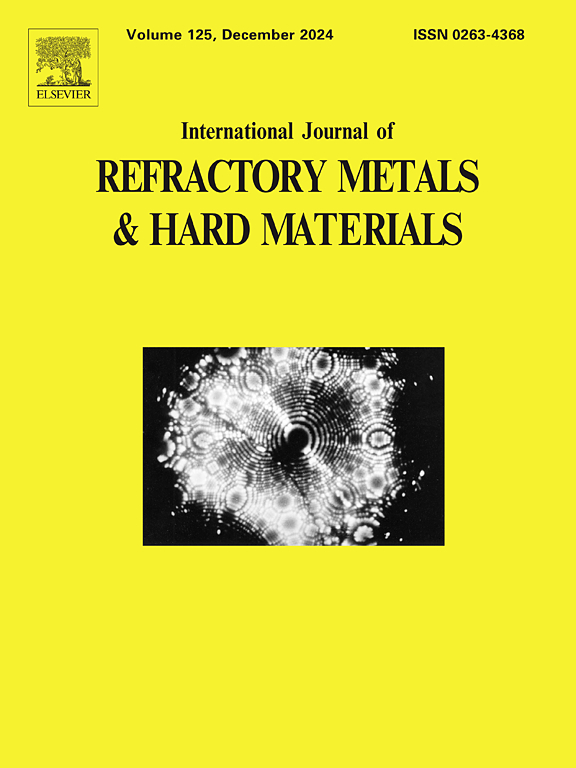Densification, microstructure and properties of 91 W-6.3Ni-2.7Fe fabricated by selective laser melting
IF 4.2
2区 材料科学
Q2 MATERIALS SCIENCE, MULTIDISCIPLINARY
International Journal of Refractory Metals & Hard Materials
Pub Date : 2025-04-26
DOI:10.1016/j.ijrmhm.2025.107207
引用次数: 0
Abstract
Tungsten is a refractory metal with high density and is widely used in aerospace, medical, and nuclear applications due to its robust performance characteristics. In this study, 91 W-6.3Ni-2.7Fe alloys were fabricated via Selective Laser Melting (SLM). This study delves into the impacts of scanning speed on the densification, microstructure, and mechanical properties of the 91 W-6.3Ni-2.7Fe alloy under the conditions of a laser power of 200 W, scanning pitch of 0.08 mm, and powder layer thickness of 0.03 mm. The investigation demonstrates that an optimal scanning speed of 175 mm/s yields a relative density of 96.89 %, a performance attributed to a balanced energy input that facilitates efficient powder melting and consolidation. This optimized condition further promotes the formation of a microstructure dominated by a high-W phase intertwined with a W-Ni-Fe intermetallic phase, which underpins the alloy's microhardness of 610 HV and tensile strength of approximately 800 MPa. In contrast, higher scanning speeds (≥600 mm/s) introduce reduced energy per unit length, leading to the development of dendritic structures that deteriorate the material’s performance.
选择性激光熔化制备91 W-6.3Ni-2.7Fe合金的致密化、显微组织和性能
钨是一种高密度难熔金属,由于其坚固的性能特点,被广泛应用于航空航天、医疗和核领域。采用选择性激光熔化法制备了91种W-6.3Ni-2.7Fe合金。在激光功率为200 W、扫描间距为0.08 mm、粉末层厚度为0.03 mm的条件下,研究了扫描速度对91 W-6.3 ni -2.7 fe合金致密化、显微组织和力学性能的影响。研究表明,175 mm/s的最佳扫描速度可产生96.89%的相对密度,这一性能归功于平衡的能量输入,有助于有效的粉末熔化和固结。该优化条件进一步促进了高w相与W-Ni-Fe金属间相交织的微观结构的形成,使合金的显微硬度达到610 HV,抗拉强度约为800 MPa。相反,较高的扫描速度(≥600mm /s)会降低单位长度的能量,导致枝晶结构的发展,从而降低材料的性能。
本文章由计算机程序翻译,如有差异,请以英文原文为准。
求助全文
约1分钟内获得全文
求助全文
来源期刊
CiteScore
7.00
自引率
13.90%
发文量
236
审稿时长
35 days
期刊介绍:
The International Journal of Refractory Metals and Hard Materials (IJRMHM) publishes original research articles concerned with all aspects of refractory metals and hard materials. Refractory metals are defined as metals with melting points higher than 1800 °C. These are tungsten, molybdenum, chromium, tantalum, niobium, hafnium, and rhenium, as well as many compounds and alloys based thereupon. Hard materials that are included in the scope of this journal are defined as materials with hardness values higher than 1000 kg/mm2, primarily intended for applications as manufacturing tools or wear resistant components in mechanical systems. Thus they encompass carbides, nitrides and borides of metals, and related compounds. A special focus of this journal is put on the family of hardmetals, which is also known as cemented tungsten carbide, and cermets which are based on titanium carbide and carbonitrides with or without a metal binder. Ceramics and superhard materials including diamond and cubic boron nitride may also be accepted provided the subject material is presented as hard materials as defined above.

 求助内容:
求助内容: 应助结果提醒方式:
应助结果提醒方式:


